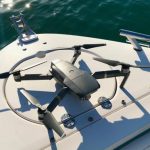When the client took delivery of the yacht, the external sun deck cinema was partially automated. A projector had been installed into a drop-down ceiling lift and the screen needed to be built by the crew, as well as the need to deploy speakers in various locations that then meant cables running across the deck. The process wasn’t quick – it took over an hour, had to be planned in advance, and could only really be done when the area was free of guests.
Yacht Intelligence were tasked with creating a bespoke solution that would alleviate this inconvenience and hassle, and enable ‘movie night’ at the touch of a button.
There’s no such thing as a marine-approved, automated cinema screen for exterior use. Hence the need for it to be a bespoke setup. With regard to the speakers, even the big-name manufacturers only supply big and unsightly boxes, not suitable for the world of superyachts, and others only offer extremely overpriced solutions.
We approached the project in two parts:
a) The design and manufacture of a custom external screen
b) The design and manufacture of rail mounted exterior speakers and the identification of locations for wired-in speakers, installed to the bulkheads.
Throughout the process, Covid presented us with additional challenges. The review and planning all had to be done remotely and a lot of trust was placed in the engineering team on board. For us, it’s second nature but for the engineers on board we needed to be clear and specific with the information we required and guide them through it.
The design of the speakers was less challenging than the screen. We decided early on that we wanted a flat back speaker and took inspiration from the 1960’s and the various old-school jukebox-style speakers, and this influenced the final style and shape. We tend to use JL Audio exterior speakers on most of our projects and we felt their new Lux range would be ideal. We spent many hours styling and rendering, and once we had agreed on the look, we amended it to house the JL Audio 8” Luxe speaker.
We worked closely with the fabricators to ensure the moulds would allow the speakers to be easily mounted from the front, and that we had sufficient access for the interior cabling and connector on the back. For the rear connections and pole mounting options, we selected off-the-shelf IP67 rated sockets/covers and plugs.
The Screen was a complex project with various considerations and challenges to overcome, particularly with regard to serviceability going forward. The need to mount on site to a raked-back surface had a massive influence on the design of the final chassis/mount, not to mention the marine environment and the issues that come with it; vibration, storms/bad weather, sea water, and the day-to-day wash-down of the screen chassis itself also had to be considered. On top of this, we had to ensure the unit was structurally sound, easy to mount and easy to integrate with the yacht’s current control system and already- installed projector.
A primary concern was ensuring that the unit did not retain any water, or suffer from water ingress. To mitigate this risk, rather than installing the unit flush to the yacht’s surface, it was stood off to allow for water to flow behind the chassis and, in essence, avoid standing water, etc. In addition, we had to ensure that if the aluminium screen chassis and the fibreglass chassis sweated, that the water had somewhere to go and the base of the screen, or trough as we call it, could collect it and disperse it.
The most challenging part of the project was the mounting of a 4 metre-plus chassis to the yacht, without a crane, and requiring a big lift crew, and secondly the shipping of such a large unit to the US from the UK.
After extensive analysis, we settled on x2 v-shaped mounting points that allow the chassis to be slotted down onto them. These mounts were hollow in the middle, allowing the cabling to be passed through and sealed up with an adjustable collar. With the help of a local carbon fibre engineer, the yacht’s structure was drilled out and our innovative design ensured that no extra structural support was necessary.
Delivery of the screen/chassis itself was no small task. The completed unit was too big for standard airline cargo and commercial freight storage holds, so we shipped it to Luxembourg where it was loaded onto a nose-opening plane that allowed for the transport container to be pushed into the plane’s hold with ease.
The whole project was completed in an astonishing eight-week timeframe. From receiving the order, to producing the designs, finding a fabricator, building and testing components, and shipment to the US.
Installation on site took two days, and was a meticulously planned operation with our team arriving in the US ahead of the screen to prepare for installation. There were some expected challenges, due to some of the integration to the current AV/IT system that couldn’t have been foreseen, but a solution was found and approved with the client on site. It was deployed and completed within 24 hours.
For those seeking something similar, the possibilities are enormous. We produced the same speakers for another client, using a special paint process that would allow the speakers to work aesthetically within all manner of interior locations. They are also a brilliant solution where speakers cannot be integrated as standard to ceilings or bulwarks.
This solution is ideal for refit projects where an existing framework or structure needs to be worked with. For outdoor cinema setups, Yacht Intelligence has highlighted once again how their progressive design approach, high-quality build and seamless integration is industry leading.









